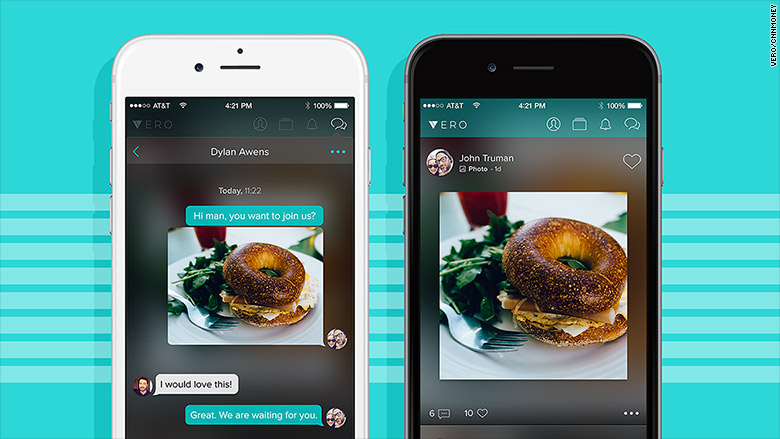
If you follow any major influencers or celebrities on social media, you might have noticed a new social platform called Vero. That’s right, alongside Facebook, Instagram, Snapchat, Twitter, LinkedIn, Youtube, and a handful of other platforms, people still have time for another one.
With its quick spike in attention and users, it might feel necessary to get involved at the ground floor with Vero. But does your restaurant need Vero? Before you run to the app and get your restaurant registered, there are a few things you need to know about Vero and whether it will be around for the long haul.
It’s Like Instagram with Chronological Posting
The biggest feature people talk about with Vero is that it’s like Instagram but with a chronological posting feed. Often a major gripe for Instagram users is the inability to just scroll through the feed by what is most recent, instead having to rely on the platform’s algorithm for what it thinks you want to see.
But Vero is not just an Instagram clone. The best way to describe it is a mesh of every other major social media platform. There is definitely a heavy emphasis on visual media like pictures and videos, but users can do more than that. They can post what books they are reading, music they are listening to, movies they are watching, and more. Each of these posts can act like a mini review, letting users praise or bash on different media.
One dangerous aspect of Vero’s business model, though, is that it won’t always be free. The first million users get free accounts for life, but Vero plans on charging a subscription fee thereafter. There is no information on how much they will charge, and that extra cost no doubt will turn away many users. Younger users, like teenagers and younger, won’t even have Vero as an option without disposable income, and others will balk at the idea of paying for social media when the rest are free.
Vero is Still in Beta, and You Can Tell
Vero has been around since 2015, but has never had this kind of attention. Because of this quick spike, their servers are having a hard time keeping up with the demand. Personally, it took over 30 minutes to sign up for the service, with it denying my authentication code multiple times before finally accepting it. Then, it’s been a one in six chance of actually getting back into the app.
This doesn’t bode well for the thousands of people trying it out off of the suggestions of influencers they follow. Many will likely sign up, feel the growing pains of the new service, and leave. Many features are not fully fleshed out and are done better by other platforms. First impressions are important, and right now many are frustrated with Vero.
One major feature that is missing, though, is connecting your Vero account to other social media to find friends easily. Basically, you have to start fresh finding people to follow; something nobody wants to do. For a business on the app, that means a lot of work self-promoting your Vero account on other social media platforms.
Not Really Business Friendly
It’s clear that Vero’s long-term plan is not to rely on ad revenue like most social media platforms. They’ve stated that only the first million users get free accounts and that everybody after that have to pay to be on Vero. They’re hoping that once they get a foothold in the social media business, they can gain revenue from users, not businesses.
That means there isn’t a focus on helping businesses market themselves. Vero prides on their ad-free subscription model, meaning you can’t pay to get in front of millions of users.
That leaves restaurants two choices: either pay an influencer to promote your restaurant, or build a profile and following naturally. One major difference to Vero from other platforms though is being able to sell products directly on it. Instead of redirecting to new website, you can make purchases on the app, with Vero pocketing a small percentage.
For restaurants though, this feature isn’t helpful. Maybe in the future they’ll add a feature for delivering food to compete with UberEats or such, but as it stands now, not very useful.
Another downside is the lack of hard data for users and businesses. Outside of comments and likes, you have no idea how many people are actually seeing your post. In today’s world, businesses run on data and not giving businesses on Vero access to some analytics means many won’t even consider it.
A Visual Platform Requiring Visual Content
Vero is very much a visual social media platform. Currently, users can’t just write a text post; they must use a photo/video or link to a website. That means lots of photos and videos in Vero’s feed, with the occasional review and recommendation.
Visual content is very effective in engaging with users, but can be hard for restaurants without experience in it. If you don’t already have a strong presence on other visual social media, like Instagram or Snapchat, Vero might not be the place to start it. Since it is so new and doesn’t have a ton of users, it will be more worth your time trying your hand at Instagram.
On the other hand, if your restaurant is on Instagram, but you’re finding barriers because of its algorithms, Vero might be worth a try. You could even post the same content on both Instagram and Vero and see which brings you more results. After a few months of work, you might see results in Vero because of their algorithmic differences you can’t achieve in Instagram. Just be sure to let your followers know you are on Vero so you can build an audience there quickly.
Time Will Tell on Vero
It’s clear that Vero has a long way to go and needs to do a lot to prove it’s worth your time. Don’t put all of your social media marketing eggs in the Vero basket just yet. Spend most of your effort and money into proven social media like Facebook, Twitter, Instagram and such.
As it is right now, Vero is not a required social media for restaurants. Because of its quick spark of popularity, it might be worth creating a free account while they are available and tinkering with, just in case it does grow more popular. Don’t expect it to overthrow Instagram overnight, or even in a year. While there are many nice features for the average user, there is little of value to most businesses, most of all restaurants.






